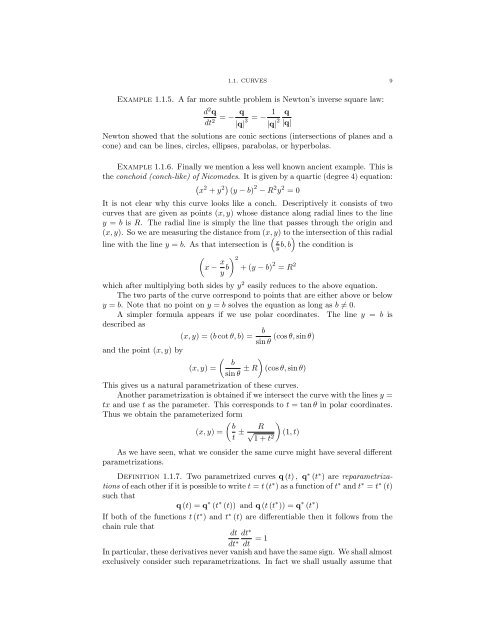Lecture Notes for 120 - UCLA Department of Mathematics
Lecture Notes for 120 - UCLA Department of Mathematics
Lecture Notes for 120 - UCLA Department of Mathematics
You also want an ePaper? Increase the reach of your titles
YUMPU automatically turns print PDFs into web optimized ePapers that Google loves.
1.1. CURVES 9<br />
Example 1.1.5. A far more subtle problem is Newton’s inverse square law:<br />
d 2 q<br />
dt 2 = q<br />
|q| 3 = 1 q<br />
|q| 2 |q|<br />
Newton showed that the solutions are conic sections (intersections <strong>of</strong> planes and a<br />
cone) and can be lines, circles, ellipses, parabolas, or hyperbolas.<br />
Example 1.1.6. Finally we mention a less well known ancient example. This is<br />
the conchoid (conch-like) <strong>of</strong> Nicomedes. It is given by a quartic (degree 4) equation:<br />
x 2 + y 2 (y b) 2 R 2 y 2 =0<br />
It is not clear why this curve looks like a conch. Descriptively it consists <strong>of</strong> two<br />
curves that are given as points (x, y) whose distance along radial lines to the line<br />
y = b is R. The radial line is simply the line that passes through the origin and<br />
(x, y). Sowearemeasuringthedistancefrom(x, y) to the intersection <strong>of</strong> this radial<br />
line with the line y = b. Asthatintersectionis<br />
✓<br />
x<br />
x<br />
y b ◆ 2<br />
+(y b) 2 = R 2<br />
⇣<br />
x<br />
y b, b ⌘<br />
the condition is<br />
which after multiplying both sides by y 2 easily reduces to the above equation.<br />
The two parts <strong>of</strong> the curve correspond to points that are either above or below<br />
y = b. Notethatnopointony = b solves the equation as long as b 6= 0.<br />
A simpler <strong>for</strong>mula appears if we use polar coordinates. The line y = b is<br />
described as<br />
and the point (x, y) by<br />
(x, y) =(b cot ✓, b) =<br />
b (cos ✓, sin ✓)<br />
sin ✓<br />
✓ ◆ b<br />
(x, y) =<br />
sin ✓ ± R (cos ✓, sin ✓)<br />
This gives us a natural parametrization <strong>of</strong> these curves.<br />
Another parametrization is obtained if we intersect the curve with the lines y =<br />
tx and use t as the parameter. This corresponds to t = tan ✓ in polar coordinates.<br />
Thus we obtain the parameterized <strong>for</strong>m<br />
✓ ◆<br />
b<br />
(x, y) =<br />
t ± R<br />
p (1,t)<br />
1+t<br />
2<br />
As we have seen, what we consider the same curve might have several different<br />
parametrizations.<br />
Definition 1.1.7. Two parametrized curves q (t) , q ⇤ (t ⇤ ) are reparametrizations<br />
<strong>of</strong> each other if it is possible to write t = t (t ⇤ ) as a function <strong>of</strong> t ⇤ and t ⇤ = t ⇤ (t)<br />
such that<br />
q (t) =q ⇤ (t ⇤ (t)) and q (t (t ⇤ )) = q ⇤ (t ⇤ )<br />
If both <strong>of</strong> the functions t (t ⇤ ) and t ⇤ (t) are differentiable then it follows from the<br />
chain rule that<br />
dt dt ⇤<br />
dt ⇤ dt =1<br />
In particular, these derivatives never vanish and have the same sign. We shall almost<br />
exclusively consider such reparametrizations. In fact we shall usually assume that
















